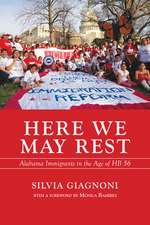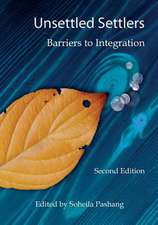Internally Displaced Persons and International Refugee Law
Autor Bríd Ní Ghráinneen Limba Engleză Hardback – 31 mar 2022
Preț: 592.75 lei
Preț vechi: 748.46 lei
-21% Nou
Puncte Express: 889
Preț estimativ în valută:
113.44€ • 117.99$ • 93.65£
113.44€ • 117.99$ • 93.65£
Carte disponibilă
Livrare economică 11-17 martie
Preluare comenzi: 021 569.72.76
Specificații
ISBN-13: 9780198868446
ISBN-10: 0198868448
Pagini: 240
Dimensiuni: 164 x 241 x 18 mm
Greutate: 0.53 kg
Editura: OUP OXFORD
Colecția OUP Oxford
Locul publicării:Oxford, United Kingdom
ISBN-10: 0198868448
Pagini: 240
Dimensiuni: 164 x 241 x 18 mm
Greutate: 0.53 kg
Editura: OUP OXFORD
Colecția OUP Oxford
Locul publicării:Oxford, United Kingdom
Recenzii
Internally Displaced Persons and International Refugee Law investigates the protection of internally displaced people in and beyond refugee law.
This book interrogates the relationship between international refugee law and the legal regime as it relates to IDPs, exploring synergies but also possible conflicts between the two areas of law. In addition to addressing timely debates, Dr Ní Ghráinne's book is noteworthy for its meticulous research and methodology. Ostensibly a refugee law scholar, Dr Ní Ghráinne is, I suspect, a Public International Law scholar at heart, and she brings an impressive doctrinal knowledge of that broader field to bear on her specialist area. Furthermore, she is alive to what States - and UNHCR - actually do, mindful of the importance of State practice in the formation of customary international law. In short, this book makes a significant contribution to knowledge and scholarship, filling the void in the literature on the precise relationship between international refugee law and the law relating to IDPs.
This is an excellent book that refreshes a first detailed analysis of the relationship between the protection of Internally Displaced Persons (IDPs) and international refugee law. Dr Brid Ni Ghrainne must be congratulated for her unique scholarly approach... she provides a sophisticated analysis of the legal and normative relationship between IDPs and refugees, of the extent to which an individual's real risk of internal displacement in their country of origin is relevant to the qualification and cessation of refugee status, and whether the availability of IDP protection may entail an alternative to asylum.
Ever since internal displacement emerged as a significant concern on the international agenda, refugee advocates and proponents of increased protection for internally displaced persons (IDPs) have grappled with the thorny question of the relationship between refugees and IDPs, and whether strengthened efforts in support of IDPs pose a risk to refugee protection. Through clear and compelling legal analysis, Bríd Ní Ghráinne illuminates the implications of international refugee law for those uprooted within their own countries, convincingly demonstrating that the international frameworks developed since the 1990s to protect IDPs do not undermine refugee law. This book is essential reading for anyone concerned about the protection of those forced from their homes, whether they be refugees or internally displaced persons.
While internally displaced persons and refugees often face similar challenges, they differ fundamentally in legal terms. While the latter enjoy international protection, the former remain subject to the jurisdiction of their own government. Bríd Ní Ghráinne's original study of the relationship between refugee law and the evolving legal regime pertaining to IDPs fills an important gap. It is a highly relevant contribution not only to the study of UNHCR's mandate and the interpretation of the 1951 Refugee Convention but also to the still under-researched field of internal displacement.
This is an exceptional piece of legal scholarship dealing with one of the most important global issues of our time. It presents an incisive and thoughtful critique of the inter-relationship between the emerging law of internal displacement and the more established field of refugee law. It is no small feat to effectively present such a discussion in an accessible manner, yet Dr Ní Ghráinne masterfully achieves this. It is a fascinating, thought-provoking, and highly-recommended read, which speaks not only to law but also to how we define, value and protect human life.
This monograph is an important milestone in the study of internally displaced persons' (IDP) protection. Ní Ghráinne's book brilliantly helps us understand how the legal and institutional framework of IDP protection has developed and interacts with international refugee law, complementary protection, and the internal flight alternative. She convincingly demonstrates that the increase in IDP protection does not, as a matter of law, undermine refugee protection. Given its extremely insightful, thorough, and documented analysis, this monograph will certainly become an indispensable point of reference for anyone following IDP policies and, more generally, international refugee law.
This book interrogates the relationship between international refugee law and the legal regime as it relates to IDPs, exploring synergies but also possible conflicts between the two areas of law. In addition to addressing timely debates, Dr Ní Ghráinne's book is noteworthy for its meticulous research and methodology. Ostensibly a refugee law scholar, Dr Ní Ghráinne is, I suspect, a Public International Law scholar at heart, and she brings an impressive doctrinal knowledge of that broader field to bear on her specialist area. Furthermore, she is alive to what States - and UNHCR - actually do, mindful of the importance of State practice in the formation of customary international law. In short, this book makes a significant contribution to knowledge and scholarship, filling the void in the literature on the precise relationship between international refugee law and the law relating to IDPs.
This is an excellent book that refreshes a first detailed analysis of the relationship between the protection of Internally Displaced Persons (IDPs) and international refugee law. Dr Brid Ni Ghrainne must be congratulated for her unique scholarly approach... she provides a sophisticated analysis of the legal and normative relationship between IDPs and refugees, of the extent to which an individual's real risk of internal displacement in their country of origin is relevant to the qualification and cessation of refugee status, and whether the availability of IDP protection may entail an alternative to asylum.
Ever since internal displacement emerged as a significant concern on the international agenda, refugee advocates and proponents of increased protection for internally displaced persons (IDPs) have grappled with the thorny question of the relationship between refugees and IDPs, and whether strengthened efforts in support of IDPs pose a risk to refugee protection. Through clear and compelling legal analysis, Bríd Ní Ghráinne illuminates the implications of international refugee law for those uprooted within their own countries, convincingly demonstrating that the international frameworks developed since the 1990s to protect IDPs do not undermine refugee law. This book is essential reading for anyone concerned about the protection of those forced from their homes, whether they be refugees or internally displaced persons.
While internally displaced persons and refugees often face similar challenges, they differ fundamentally in legal terms. While the latter enjoy international protection, the former remain subject to the jurisdiction of their own government. Bríd Ní Ghráinne's original study of the relationship between refugee law and the evolving legal regime pertaining to IDPs fills an important gap. It is a highly relevant contribution not only to the study of UNHCR's mandate and the interpretation of the 1951 Refugee Convention but also to the still under-researched field of internal displacement.
This is an exceptional piece of legal scholarship dealing with one of the most important global issues of our time. It presents an incisive and thoughtful critique of the inter-relationship between the emerging law of internal displacement and the more established field of refugee law. It is no small feat to effectively present such a discussion in an accessible manner, yet Dr Ní Ghráinne masterfully achieves this. It is a fascinating, thought-provoking, and highly-recommended read, which speaks not only to law but also to how we define, value and protect human life.
This monograph is an important milestone in the study of internally displaced persons' (IDP) protection. Ní Ghráinne's book brilliantly helps us understand how the legal and institutional framework of IDP protection has developed and interacts with international refugee law, complementary protection, and the internal flight alternative. She convincingly demonstrates that the increase in IDP protection does not, as a matter of law, undermine refugee protection. Given its extremely insightful, thorough, and documented analysis, this monograph will certainly become an indispensable point of reference for anyone following IDP policies and, more generally, international refugee law.
Notă biografică
Bríd Ní Ghráinne is an Assistant Professor in Law at Maynooth University; Senior Researcher at the Judicial Studies Institute, Masaryk University; Senior Affiliate and Lecturer at the Refugee Law Initiative, University of London; Senior Non-Resident Fellow at the Institute of International Relations Prague; and Visiting Research Fellow at the University of Reading. She holds a DPhil from the University of Oxford; an LLM in Public International Law from Universiteit Leiden; and a BCL (International) from the National University of Ireland, Galway. She has published widely on the topics of forced migration and human rights law.



















